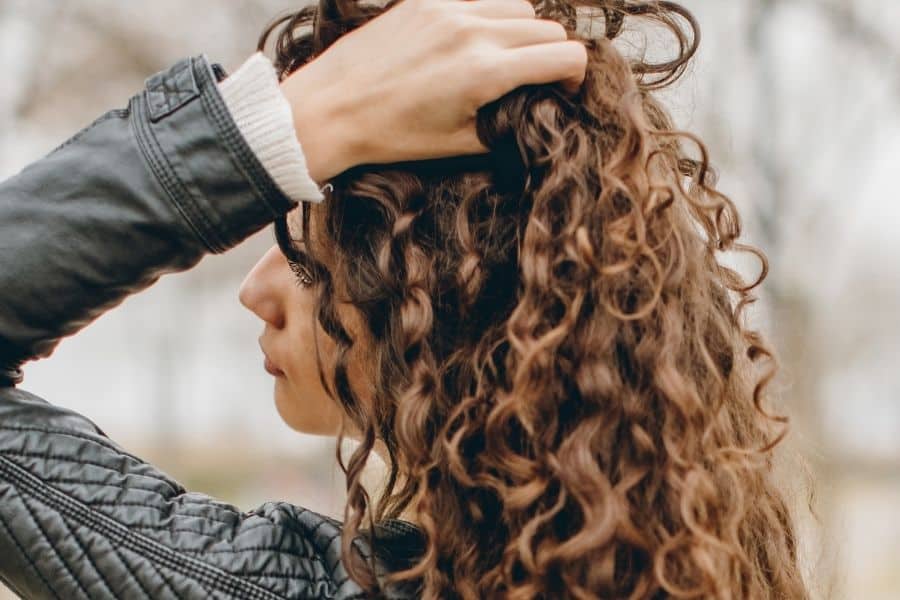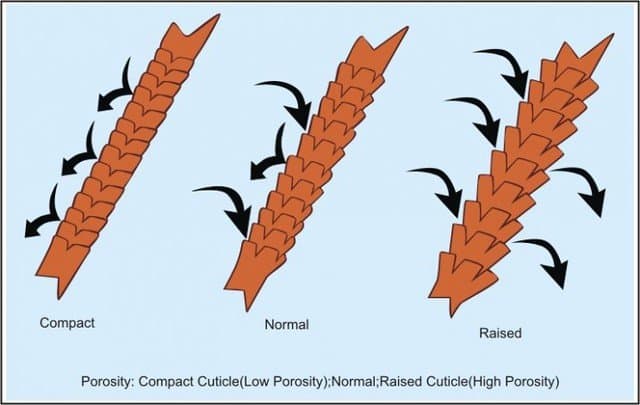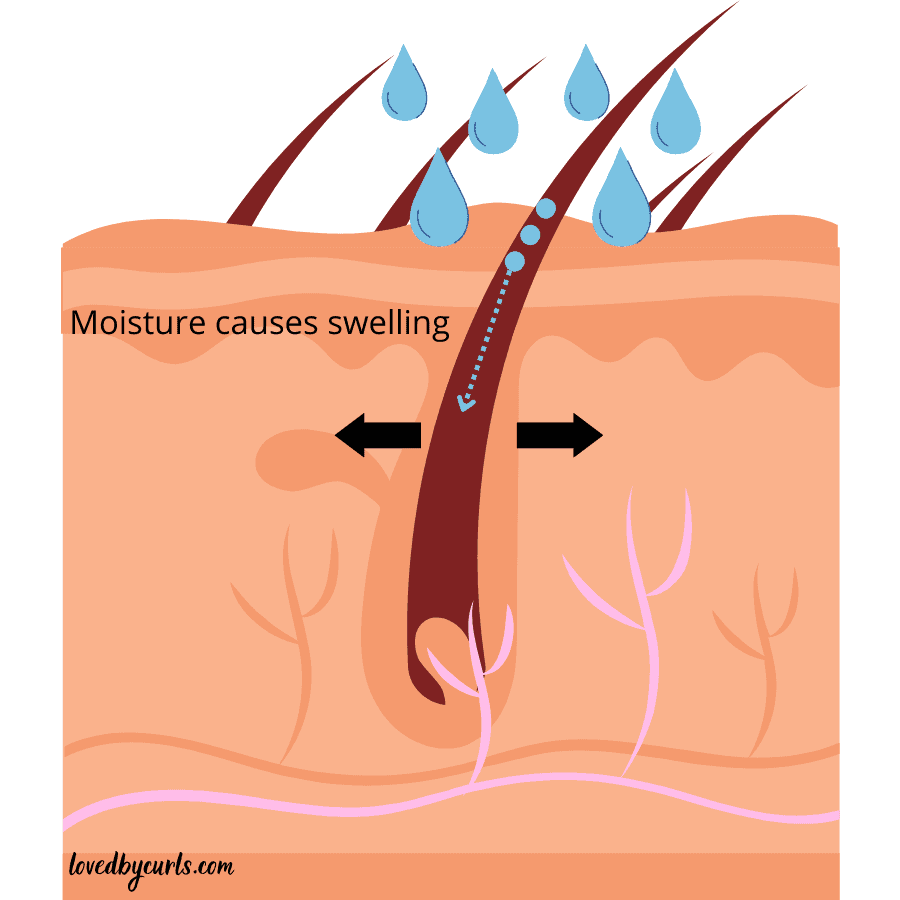If your hair feels limp, flat, and won’t curl, then you’re most likely suffering from moisture overload. This means that you have too much moisture in your hair which will need to be balanced out. In this article, I show you exactly how to identify the symptoms, how to fix moisture overload, and how to bring life back to your curls.

This post contains affiliate links and we may earn if you click on them (at no extra cost to you). Please read our full disclosure policy here.
The important Balance Between Moisture And Protein In hair
The human hair is made of 95% keratin which is a fibrous structural protein and helps to keep your hair healthy. Protein protects the inner cortex and keeps your hair strong. It also encourages hair to grow faster and thicker.
Moisture is also an important factor when it comes to hair health. Moisture keeps your hair flexible and gives your hair strands elasticity.
Moisture is also good for scalp health and keeps your hair looking shiny and soft while preventing dry hair which can cause breakage.
The balance between moisture and protein is therefore vital.
If you have too much protein in your hair, it can become dry and brittle. If you have too much moisture in your hair, your hair will turn soft and limp.
What Is Moisture Overload?
Moisture overload happens when there is an imbalance between the protein levels and moisture levels in your hair.
The condition particularly affects hair that has been damaged by heat styling or chemical treatments or people with high porosity hair.
High porosity hair means that your hair cuticles easily absorb moisture. This is because their structural wall, which is made up of scale-like tiles, has been compromised and moisture can therefore easily penetrate.

When too much moisture enters the hair cuticle, the balance between protein and moisture is off and this will cause your hair to turn soft, stringy, and perhaps even greasy.
Although the condition can be reversed, it should be done as soon as you suspect you may be suffering from over-moisturized hair. This is because it can turn into another condition called hygral fatigue.
Hygral fatigue is a more serious condition where the follicles have become damaged due to swelling caused by excess moisture.
This includes damage to the cuticle cells, loss of the protective outer layer of your hair as well as exposure of the inner cortex of your hair follicle.

What happens with hygral fatigue is that every time your hair gets wet, your hair strands swell up and stretch. However, as the hair is unable to retain water due to damage, hair quickly becomes dry again.
It is a condition that can take a long time to fix, so if you suspect your hair is over-moisturized, make sure to act quickly.
What Causes Moisture Overload?
The main culprit of over-moisturized hair is simply your haircare routine and you may find that you are doing one of the following:
- Washing your hair too often
- Over-conditioning
- Leaving hair wet for hours or overnight
- Overuse of deep conditioner
- Never using protein products
We’re so used to being told that our hair needs nourishment that we apply far too much conditioner, deep conditioner, and moisturizing creams to our hair.
This is particularly the case if you’re a follower of the Curly Girl Method. Endless articles and adverts promote moisture and hydration as the key to frizz-free curls.
This works well for people who have low porosity hair, meaning hair that does not absorb moisture easily.
However, people with high porosity hair should be careful with how much product they use.
Consider these statements:
- Do you wash your hair more than twice a week?
- Do you deep condition more than once a week?
- Do you sleep with your hair wet at night?
- Do you use moisturizing creams?
- Does your hair easily absorb water and products?
If two or more of the above statements ring true, you may well be at risk of moisture overload.
For more information about the Curly Girl Method, check out my easy guide.
What about protein overload?
Protein overload is of course the opposite of over-moisturized hair and can occur if you continuously overuse protein-rich hair products.
This can easily happen as it is often recommended by experts that you do a protein treatment to restore your hair’s natural health.
However, just like your hair can become over-moisturized from over-washing, the protein-moisture balance can be disturbed if you have too much protein in your hair.
Here are the most common signs that you suffer from protein overload:
- Hair feels dry, brittle, and easily breaks
- Hair feels like straw
- Significant changes in hair texture or curl pattern
- A loss of shine
- Increased hair shedding
If you do think you’re suffering from too much protein in your hair, then you’ll need to fix it by switching up your hair products.
Also Read: 5 Important Chemicals To Avoid In Shampoo (And Why)
Signs you may have moisture overload
If you recognize more than three of the following symptoms, it’s likely that you’re suffering from moisture overload:
- Your hair feels too soft
- Your curls have stopped forming
- Hair feels limp and dull
- Hair has no volume
- Split ends and breakage
- Hair feels greasy or gummy when wet
If hair becomes over-hydrated, it will lose some of its strong core protein structure and become weak, limp, and stretchy.
If you have curls, you’ll notice that they might become flat or even disappear altogether.
One of the most telling signs is that the texture of your hair has changed.
Whereas before your hair was shiny and voluminous, it’s now dull and flat. You may also experience a change in your curl pattern and struggle to get a cast.
As already mentioned, if your hair feels very soft and you do think your hair is over-moisturized it’s very important that you do something about it as soon as possible to avoid hygral fatigue.
If your hair is allowed to progress, you may end up experiencing hygral fatigue.
How To Fix Moisture Overload

Luckily, moisture overload can easily be remedied by following these steps:
- Use a clarifying shampoo
- Switch to protein products and treatments
- Use hair oils
Let’s take a closer look.
1. Use a clarifying shampoo
One of the best ways to fix over-moisturized har is to clarify.
Clarifying is essentially a deep cleanse of your hair and scalp and gets rid of impurities, product build-up, and oil residue.
The great thing about it is that it can also help to remove excess water from your cuticles. Just what we want!
Also make sure to use a scalp brush for maximum effect and massage the product into your scalp and hair for several minutes.
If you follow the Curly Girl Method and don’t want to use shampoo, I’d recommend trying an apple cider vinegar rinse.
Simply mix 4 tablespoons of apple cider vinegar with 2 cups of water and pour over soaking wet hair.
You may not see results after the first rinse, but after the second one, my hair always feels restored.
Also Read: The BEST Apple Cider Vinegar Rinse For Curly Hair
Sometimes, you do need something a bit stronger but even if you don’t want to use a sulfate shampoo, I got you covered.
Try the As I Am Curl Clarity Shampoo or the Shea Moisture Coconut and Hibiscus Curl and Shine Shampoo.
These are both excellent clarifiers and very popular with the Curly Girl community. As they’re sulfate-free, they can be used more than once a week.
2. Use Protein Products
If you have too much moisture in your hair, you must switch your non-protein products to protein products as soon as possible. This is one of the best ways to fix over-moisturized hair.
Protein helps restore the core structure of your hair strands and it’s the best way to get rid of excess moisture.
For a sulfate-free but protein-rich shampoo, try the Shea Moisture Manuka Honey & Mafura Oil Intensive Hydration Shampoo.
It contains a rich formula of restorative oils to soften and revitalize hair and is one of Shea’s best-selling products.
For a protein-rich conditioner, you simply have to try the Shea Moisture coconut & hibiscus curl & shine conditioner.
It’s a favorite amongst all Curly Girls and with almost 1600 reviews on Amazon, you can’t really doubt how effective this conditioner truly is.
It is also important that you add a protein treatment to your new haircare routine.
Instead of a weekly deep condition, consider the Shea Moisture Manuka Honey & Yogurt Hydrate + Repair Protein-Strong Treatment (available at Amazon), or if you have some time, a rice water rinse.
Rice water rinse
If you don’t want to spend money on products, a rice water rinse may just do the trick.
Here’s what you’ll need to do:
- Add 1/2 cup of rice to 3 cups of water.
- Bring to boil then lower heat and simmer for 15 mins until the rice is cooked.
- Drain rice water and leave to cool (use rice for a meal).
- During wash routine, shampoo or co-wash hair as per usual. Add rice water to soaking wet hair and let sit on hair for 10 minutes.
- Rinse out rice water and condition as per usual.
Benefits of rice water rinse
- Increases elasticity
- Strengthens hair
- Restores shine and definition
- Combats dandruff
- Promotes hair growth
A rice water treatment should only be done once every four to six weeks. Using protein treatments is a science and shouldn’t be carried out every single week.
Remember, healthy hair consists of a balance between protein and water and you don’t want to end up on the other side which is protein overload.
3. Use Oils
Oils are often misunderstood when it comes to haircare. Although some oils can penetrate the hair shaft, they do not provide moisture as such.
What they do, is seal your hair and can even fill the hair strand so that moisture cannot penetrate. This can be beneficial when it comes to sealing in moisture.
Sealing your hair with oils can, therefore, reverse the moisture overload symptoms you may be experiencing.
How to use oils to seal hair
The best way to go about using oils in your hair is after a wash.
- Squeeze your hair for excess moisture and apply a small amount of oil between your palms.
- Rub your hands together and rake the oil through your hair.
You can also use the praying hands method if you don’t want to rake your hair and ruin your curls or apply oil after breaking your cast if you have curls.
Simply scrunch the oil into your curls for optimal effect.
You can use pretty much any oil, but I prefer this Jojoba oil from Amazon. It is certified organic and 100% pure natural cold-pressed.
Also Read: 5 Important Benefits Of Drinking Water For Hair (Top Tips)
How To Prevent Moisture Overload
There are a few things you can do to prevent your hair becoming too moisturized when washing your hair:
Don’t Wash Your Hair Too Often
If your hair feels soft and limp, you’ll want to limit the number of times you wet your hair during the week.
Washing your hair twice a week should be enough but if you do need to wash it more often than that, consider skipping conditioner during one of the washes.
Squeeze Out Excess Water
During every wash, squeeze out as much water from your hair as possible. If you have curly hair, try to style on damp hair rather than soaking wet hair.
You don’t want to seal in more moisture than necessary and remember to use a protein gel if you can.
Avoid Deep Conditioning
Usually, we’re told to deep condition once a week, but if you suffer from moisture overload, this is a no-go.
Instead, focus on using protein products and do a protein treatment once every 4 to 6 weeks.
Remember, the goal is to reverse moisture overload so avoid hydrating your hair with additional products.
Keep your routine simple and find protein products that fit your budget and style.
Why Is Moisture Overload So Bad For Curly Hair?
In general, curls are drier than straight hair. This is because it takes longer for the natural oils on your scalp to travel down the hair shaft and hydrate the hair.
It is therefore essential to moisturize curly hair and this is often done with deep conditioning treatments and hair masks.
However, over-moisturized hair can have a big effect on your curls. Too much moisture will weaken the structural foundation of the hair strands, making them too soft and limp for your curls to form.
It is therefore not uncommon to see a change in curl pattern if you suffer from too much moisture in your hair and it can take a while to get your curls back.
If you find that your hair texture has changed or your curl pattern has loosened, try a clarifying shampoo and use protein products for a few weeks. This should help get you back on the right track.
Frequently Asked Questions (FAQ)
Can you over-moisturize your hair?
It is possible to over-moisturize your hair by washing your hair too frequently or using the wrong products on damaged hair. Change your hair routine to include protein products and limit washing to once per week.
If your hair feels soft, limp, and lacks volume, you may be suffering from moisture overload. However, if your hair feels straw-like, easily breaks, and has no shine, you’re likely suffering from protein overload.
Over-moisturized hair can feel gummy to the touch. It’s very soft and feels weak and brittle.
If your hair feels lifeless, soft, and limp, you may have hygral fatigue. If you have curls, your texture may have changed and your curls have stopped forming.
Disclaimer: This site is not intended to provide professional or medical advice. All of the content on LovedByCurls.com is for informational purposes only. All advice should be followed at your own discretion. Ingredients may change at any time so always check the product label before using. Check our full disclaimer policy here.






